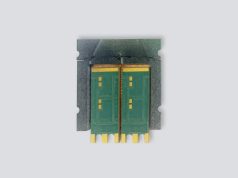Additive manufacturing, can create custom parts for electromagnetic devices on-demand and at a low cost. These devices are highly sensitive, and each component requires precise fabrication. Until recently, though, the only way to diagnose printing errors was to make, measure and test a device or to use in-line simulation, both of which are computationally expensive and inefficient.
To remedy this, a research team co-led by Penn State created a first-of-its-kind methodology for diagnosing printing errors with machine learning in real time. The researchers describe this framework — published in Additive Manufacturing — as a critical first step toward correcting 3D-printing errors in real time. According to the researchers, this could make printing for sensitive devices much more effective in terms of time, cost and computational bandwidth.
“A lot of things can go wrong during the additive manufacturing process for any component,” said Greg Huff, associate professor of electrical engineering at Penn State. “And in the world of electromagnetics, where dimensions are based on wavelengths rather than regular units of measure, any small defect can really contribute to large-scale system failures or degraded operations. If 3D printing a household item is like tuning a tuba — which can be done with broad adjustments — 3D-printing devices functioning in the electromagnetic domain is like tuning a violin: Small adjustments really matter.”
In a previous project, the researchers had attached cameras to printer heads, capturing an image every time something was printed. While not the primary purpose of that project, the researchers ultimately curated a dataset that they could combine with an algorithm to classify types of printing errors.
“Generating the dataset and figuring out what information the neural network needed was at the heart of this research,” said first author Deanna Sessions, who received her doctorate in electrical engineering from Penn State in 2021 and now works for UES Inc. as a contractor for the Air Force Research Laboratory. “We’re using this information — from cheap optical images — to predict electromagnetic performance without having to do simulations during the manufacturing process. If we have images, we can say whether a certain element is going to be a problem. We already had those images, and we said, ‘Let’s see if we can train a neural network to (identify the errors that create problems in performance).’ And we found that we could.”
When the framework is applied to the print, it can identify errors as it prints. Now that the electromagnetic performance impact of errors can be identified in real time, the possibility of correcting the errors during the printing process is much closer to becoming a reality.
“As this process is refined, it can start creating that kind of feedback control that says, ‘The widget is starting to look like this, so I made this other adjustment to let it work,’ so we can keep on using it,” Huff said.
The other authors of the paper were: Venkatesh Meenakshisundaram of UES Inc. and the Air Force Research Laboratory; Andrew Gillman and Philip Buskohl of the Air Force Research Laboratory; Alexander Cook of NextFlex; and Kazuko Fuchi of the University of Dayton Research Institute and the Air Force Research Laboratory.
Funding was provided by the U.S. Air Force Office of Scientific Research and the U.S. Air Force Research Laboratory Minority Leadership Program.
Published in: Additive Manufacturing
Subscribe to our Newsletter
3DPResso is a weekly newsletter that links to the most exciting global stories from the 3D printing and additive manufacturing industry.
























